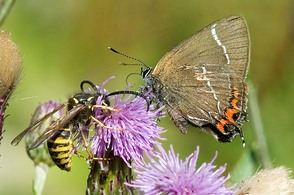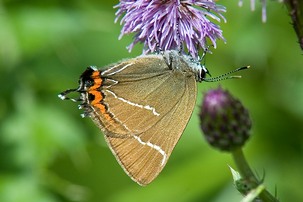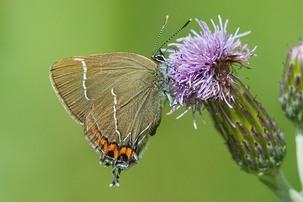

Biodiversity
Action
Plan
White-letter Hairstreak: a small/medium-sized, elm-dependent butterfly with the erratic, spiralling flight typical of hairstreaks.
It always lands with closed, beige-brown wings, with a characteristic white letter W on the underside. On its rear wings it has tails next to a decreasing orange band with black spots.
White-lettered Hairstreak is scarce and highly localised in Barnsley.
White-letter Hairstreak Satyrium w-album
UKBAP Priority Species
S41 Species of Principal Importance
Red List: Endangered.
BC Conservation Priority: HIGH.
Schedule 5 species.
Protection
As a species of principal importance, the presence of White-letter Hairstreak is required to be taken into consideration for conservation by any public body when performing its functions. This includes avoiding sites with a colony for development and promoting their conservation and enhancement.
In Barnsley a site with a White-letter Hairstreak colony is of sufficient priority to be designated a Local Wildlife Site which have a presumption against development requiring planning consent.
White-letter Hairstreak is protected under Schedule 5 of the 1981 Wildlife and Countryside Act against sale.
For more information including management: UK Butterflies: White-letter Hairstreak Butterfly Conservation: White-letter Hairstreak
Local Priority Habitats: Mixed deciduous woodland;Hedgerows;
Scrub; Built Environment -gardens, parks and roadsides; all with mature elm trees present.

It is found along woodland rides with mature elm trees, in sheltered hedgerows where elm suckers grow well or on isolated, mature elm trees when they remain.
The White-lettered Hairstreak spends much of its time high in the tree canopy feeding on aphid ‘honeydew’.
Suitable habitat conditions in addition to mature elm trees include open, sunny positions with flowers below for nectar.
White-letter Hairstreak is only found on or near elm trees, mainly Wych Elm in Barnsley.
Its larvae feed on elm flower buds and leaves. It is a fairly sedentary species, hardly moving from closely situated treetops.
There is one generation a year, with adults usually flying from late June to mid August. The dark brown eggs overwinter on the twig with the larvae emerging in early spring and the pupae following, formed under elm leaves and sometimes against twigs, from May to July.
Conservation: maintain elm trees in suitable habitats with appropriate flowering plants nearby for nectar.
In early morning or late afternoon, adults will usually descend for nectar from nearby flowers, favouring Creeping Thistle and Bramble.


White-letter Hairstreak butterfly